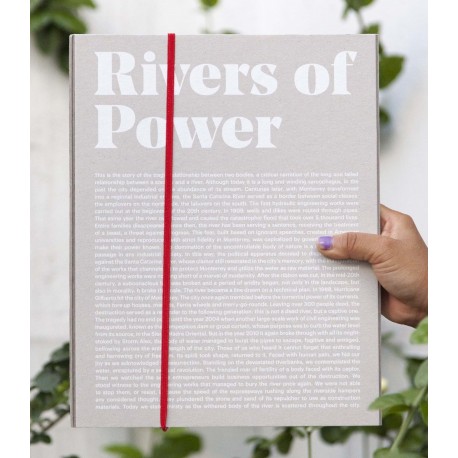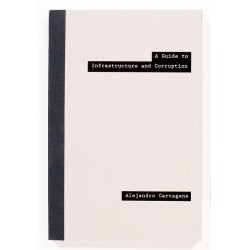Aucun produit
Rivers of Power (*signé*)
978-099666971-9
Neuf
Le texte de Xemena Peredo figure en anglais d'un côté de l'étui rigide, et en espagnol de l'autre côté.
Un essai de Gonzalo Ortega est présenté en espagnol et en anglais dans un petit insert de 4 pages (NB : c'est dans ce petit insert que figure la signature de l'artiste).
Le livre lui-même est inséré dans un étui en carton fort gris imprimé, ceint d'un élastique rouge. Il est présenté "emballé" dans un poster plié et fermé par un auto-collant.
À noter (!) : pour toute commande incluant au moins deux livres de Alejandro Cartagena (cf. onglet "Suggestions" ou ces liens : "Santa Barbara return jobs back to US" et "Carpoolers - 2nde édition"), nous ajouterons un poster (cf. photo) édité à 300 exemplaires à l'occasion de l'exposition Car Show de Alejandro Cartagena présentée en 2016 dans la "Galería Patrica Conde", Mexico City, Mexique.
144 pages - Couverture souple inséré dans un étui en carton fort
Co-édition Alejandro Cartagena / NEWWER, 2016 (490 ex.)
Format : 23 x 30 cm
*Signé*
Neuf - Aucun défaut
Attention : derniers livres disponibles !
En savoir plus
Texte intégral de Xemena Peredo :
"This is the story of the tragic relationship between two bodies: a critical narration of the long and failed relationship between a society and a river. Although today it is a long and winding sarcophagus, in the past the city depended on the abundance of its stream. Centuries later, with Monterrey transformed into a regional industrial enclave, the Santa Catarina River served as border between social classes: the employers on the north side, the laborers on the south.
The first hydraulic engineering works were carried out at the beginning of the 20th century. In 1909, wells and dikes were routed through pipes. That same year the river overflowed and caused the catastrophic flood that took over 5 thousand lives. Entire families disappeared. Since then, the river has been serving a sentence, receiving the treatment of a beast, with its future in peril.
This fear, built based on ignorant speeches, created in American universities and reproduced with strict fidelity in Monterrey, was capitalized by governments eager to make their power known. The domination of the uncontrollable body of nature is a necessary rite of passage in any industrial society. In this way, the political apparatus decided to display its strength against the Santa Catarina River, whose clamor still resonated in the city’s memory, with the inauguration of the works that channeled it to protect Monterrey and utilize the water as raw material.
The prolonged engineering works were nothing short of a marvel of modernity. After the ribbon was cut, in the mid-20th century, a subconscious link was broken and a period of aridity began, not only in the landscape, but also in morality. It broke the scale. The river was a line drawn on a technical plan.
In 1988, Hurricane Gilberto hit the city of Monterrey. The city once again trembled before the torrential power of its currents, which tore up houses, markets, Ferris wheels and merry-go-rounds. Leaving over 300 people dead, the destruction served as a reminder to the following generation: this is not a dead river, but a captive one.
The tragedy had no end point until the year 2004 when another large-scale work of civil engineering was inaugurated, known as the Rompepicos dam or grout curtain, whose purpose was to curb the water level from its source, in the Sierra Madre Oriental. But in the year 2010 it again broke through with all its might: stoked by Storm Alex, the body of water managed to burst the pipes to escape, fugitive and enraged, bellowing across the entire length of the city.
Those of us who heard it cannot forget that enthralling and harrowing cry of freedom. Its spirit took shape, returned to it. Faced with human pain, we hid our joy as we acknowledged its resurrection. Standing on the devastated riverbanks, we contemplated the water, enraptured by a sensual revolution. The frenzied roar of fertility of a body faced with its captor.
Then we watched the same entrepreneurs build business opportunities out of the destruction. We stood witness to the engineering works that managed to bury the river once again. We were not able to stop them, or resist, because the speed of the expressways rushing along the riverside hampers any considered thought. They plundered the stone and sand of its sepulcher to use as construction materials.
Today we stand thirsty as the withered body of the river is scattered throughout the city."

Cartagena, Alejandro
Alejandro Cartagena vit et travaille à Monterrey, au Mexique. Ses projets utilisent le paysage et le portrait comme moyen d'examiner les problèmes sociaux, urbains et environnementaux. Photo : © autoportraitA Guide to Infrastructure and Corruption...
192 pages - Couverture rigide, reliure par un adhésif The Velvet Cell, 2017 (500 ex.) Format : 14 x 21 cm *Signé* Neuf - Aucun défaut Présentation du livre par Skinnerboox : « A Guide to Infrastructure and Corruption est un projet à long terme que j'ai lancé en 2009, lorsque j'ai eu l'occasion de devenir un citoyen conscient. Un nouveau viaduc devait être...
46,00 €DisponibleBefore the War - 1ère éd. (*signed*)
.Stock épuisé.Présentation sur le site de l'artiste : "In 2008 the war against the drug cartels erupted in Mexico. The state of Nuevo Leon in northeastern Mexico became an increasingly violent place. This book is a compilation of images and texts that obsessively revisit places where the war was eventually fought and look for signs of an evil that lay...
Présentation sur le site de Alejandro Cartagena : «La guerre contre les cartels de la drogue a éclaté au Mexique en 2008. L'État de Nuevo Leon, dans le nord-est du Mexique, est devenu un lieu de plus en plus violent, un recueil d'images et de textes qui revisitent obsessionnellement les lieux de la guerre. d'un mal qui était en filigrane mais qui était...
45,00 €Rupture de stock
"V" Zine Set (*signé & numéroté*)
.Stock épuisé. Présentation par Julia Borissova : [traduction L'Ascenseur Végétal] " Je suis passionnée par le livre d'artiste et j'ai créé 14 livres au cours des 10 dernières années. La plupart de ces ouvrages sont épuisés. Il y a quelques temps, j'ai décidé de repenser à certains de mes projets et de les concevoir sous la forme nouvelle, plus...
Présentation du projet par Christopher Hery : "22:19 illustre la large palette d'émotions - peur, ennui, camaraderie, soulagement - que deux jeunes hommes ont vécu pendant une période de 8 minutes très intenses. Ce livre a été conçu de manière à révéler lentement au lecteur / regardeur l'endroit, l'histoire, et sa fin, d'une manière cinématographique. Le...
68,00 €DisponibleA Short Story (*1ère édition / signé*)
.Stock épuisé.Une histoire d'amour de 12 jours, de la première à la dernière heure...Textes (en anglais) & Images de Thomas Boivin.108 pages - Couverture souple Auto-publié, 2016 (1ère édition - 100 ex.) *Signé* Neuf - Aucun défaut





















